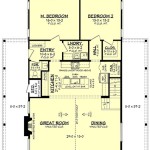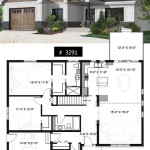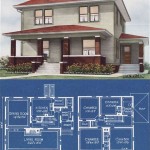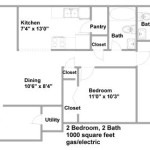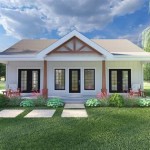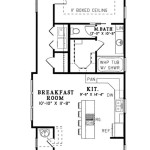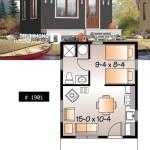Floor Plans for Single-Story Homes: A Comprehensive Guide
Single-story homes, also known as ranch-style homes, offer a multitude of advantages that appeal to a diverse range of homeowners. Their accessibility, open layout potential, and ease of maintenance contribute to their enduring popularity. Understanding the nuances of single-story floor plans is essential for prospective buyers, builders, and anyone considering a remodel. This article will explore different types of single-story floor plans, key considerations for designing or choosing one, and innovative design features that maximize space and functionality.
The appeal of single-story homes extends beyond mere aesthetics. The lack of stairs makes them ideal for individuals with mobility issues, families with young children, and those planning to age in place. The streamlined structure also simplifies cleaning, home repairs, and overall maintenance. Furthermore, single-story designs often allow for a closer connection to the surrounding landscape, blurring the lines between indoor and outdoor living.
Understanding Different Types of Single-Story Floor Plans
Single-story floor plans can be broadly classified into several categories, each offering distinct characteristics and catering to specific needs and preferences. Recognizing these different types is crucial for making an informed decision when selecting or designing a single-story home.
Ranch-Style Floor Plans: These are arguably the most recognizable type of single-story design. Characterized by their long, low profile and open layouts, ranch-style homes originated in the American Southwest. They often feature a spacious living area, a dedicated dining room, and bedrooms clustered together in one wing of the house. Ranch homes are known for their adaptability and potential for expansion, making them a popular choice for both first-time homebuyers and those seeking a more simplified lifestyle.
Open Concept Floor Plans: Open concept designs prioritize a seamless flow between living spaces, typically combining the kitchen, dining area, and living room into one large, interconnected area. This layout promotes social interaction and creates a sense of spaciousness. Single-story homes with open concept floor plans are particularly well-suited for entertaining and families who value a shared living environment. However, careful consideration should be given to noise control and zoning within the open space to maintain functionality and comfort.
Split-Bedroom Floor Plans: This type of layout strategically separates the master suite from the secondary bedrooms, providing increased privacy and tranquility for the homeowners. Split-bedroom plans are often favored by families with older children or those who frequently host guests. The master suite typically includes a private bathroom and walk-in closet, creating a secluded retreat within the home. The secondary bedrooms are usually located on the opposite side of the house, offering a clear separation of living spaces.
L-Shaped and U-Shaped Floor Plans: These designs orient the living spaces around an outdoor area, such as a patio or courtyard. This configuration allows for ample natural light and enhances the connection between indoor and outdoor living. L-shaped and U-shaped floor plans are particularly well-suited for warmer climates where outdoor living is a significant part of the lifestyle. The courtyard or patio can serve as an extension of the living space, providing a private and sheltered area for relaxation and entertainment.
Courtyard Homes: Taking the L-shaped and U-shaped floor plans a step further, courtyard homes completely enclose a central outdoor space, creating a private and serene oasis. The living spaces are arranged around the courtyard, allowing for views and access from multiple rooms. Courtyard homes offer a unique blend of privacy and connectivity, making them a popular choice for those seeking a secluded and tranquil living environment. These plans are often incorporated into modern and contemporary designs.
Key Considerations for Designing or Choosing a Single-Story Floor Plan
Selecting the right single-story floor plan requires careful consideration of individual needs, lifestyle preferences, and budget. Several key factors should be taken into account during the design or selection process to ensure a functional, comfortable, and aesthetically pleasing living space.
Functionality and Flow: The floor plan should be designed to facilitate a smooth and logical flow between different areas of the house. Consider how you will use each space and how you will move between them. A well-designed floor plan will minimize wasted space and maximize efficiency. Pay attention to the placement of doorways, hallways, and circulation paths to ensure a comfortable and intuitive living experience. Avoid creating bottlenecks or dead-end corridors that can disrupt the flow of movement.
Space Optimization: Maximizing the use of available space is crucial in single-story homes, particularly those with a smaller footprint. Consider incorporating multi-functional spaces, such as a guest bedroom that can also serve as a home office. Utilize vertical space by incorporating built-in shelving and storage solutions. Open concept designs can also create a sense of spaciousness, but it is important to define different zones within the open area to maintain functionality. Smart storage solutions, like under-bed storage or hidden compartments, are important in single-story designs.
Natural Light and Ventilation: Adequate natural light and ventilation are essential for creating a healthy and comfortable living environment. Position windows strategically to maximize sunlight exposure and cross-ventilation. Consider incorporating skylights or clerestory windows to bring natural light into interior spaces that may not have direct access to exterior walls. Proper ventilation can help regulate temperature and reduce humidity, contributing to energy efficiency and overall comfort.
Accessibility and Aging in Place: Single-story homes are inherently more accessible than multi-story homes, but it is important to consider specific accessibility features during the design or selection process. Wide doorways, grab bars in bathrooms, and lever-style door handles can make the home more accessible for individuals with mobility issues. Consider a zero-entry shower or walk-in tub for added convenience and safety. Designing with aging in place in mind ensures that the home remains comfortable and functional for years to come.
Privacy and Zoning: While open concept designs are popular, it is important to consider privacy and zoning when designing a single-story floor plan. Separate the master suite from the secondary bedrooms to provide increased privacy. Create a dedicated home office space that is separate from the main living area. Consider incorporating soundproofing measures in bedrooms and bathrooms to minimize noise transmission. Thoughtful zoning can enhance comfort and functionality, creating distinct areas for different activities.
Innovative Design Features for Single-Story Homes
Modern design trends are constantly evolving, offering innovative features that can enhance the functionality and aesthetics of single-story homes. Incorporating these design elements can elevate the living experience and create a truly unique and personalized space.
Smart Home Technology Integration: Integrating smart home technology can enhance convenience, energy efficiency, and security. Smart thermostats can automatically adjust the temperature based on occupancy and weather conditions. Smart lighting systems can be controlled remotely and programmed to create different lighting scenes. Security systems can provide peace of mind and deter intruders. Integrating these technologies seamlessly into the design can create a modern and sophisticated living environment.
Indoor-Outdoor Connectivity: Blurring the lines between indoor and outdoor living is a popular trend in single-story home design. Large sliding glass doors or folding patio doors can create a seamless transition between the interior living spaces and the outdoor environment. Consider incorporating an outdoor kitchen or dining area to extend the living space outdoors. Creating a cohesive design aesthetic between the interior and exterior spaces can enhance the sense of spaciousness and create a more inviting living environment.
Sustainable Design Elements: Incorporating sustainable design elements can reduce environmental impact and lower energy costs. Solar panels can generate electricity, reducing reliance on fossil fuels. Rainwater harvesting systems can collect rainwater for irrigation and other non-potable uses. Energy-efficient windows and insulation can reduce heat loss and gain, lowering heating and cooling costs. Using sustainable materials, such as bamboo flooring and recycled countertops, can further reduce the environmental footprint of the home.
Multi-Functional Spaces: As previously mentioned, multi-functional spaces are crucial for maximizing space in single-story homes. Consider incorporating a guest bedroom that can also serve as a home office or a playroom that can be converted into a home gym. Utilize built-in storage solutions to maximize space and minimize clutter. Designing flexible spaces that can adapt to changing needs is essential for creating a functional and comfortable living environment.
Vaulted Ceilings and Skylights: Vaulted ceilings can create a sense of spaciousness and airiness, making a single-story home feel larger than it actually is. Skylights can bring natural light into interior spaces, reducing the need for artificial lighting. Combining vaulted ceilings with skylights can create a dramatic and visually appealing living space.
Choosing the right floor plan is a critical step in creating a single-story home that meets the needs and preferences of its occupants. By carefully considering the various types of floor plans, key design considerations, and innovative design features, prospective homeowners can make an informed decision and create a living space that is both functional and aesthetically pleasing.

Pin On Homes

Stylish One Story House Plans Blog Eplans Com

Must Have One Story Open Floor Plans Blog Eplans Com

Unique One Story House Plans Monster

Durango Ranch Model Plan 3br Las Vegas Single Story House Floor Plans 5 Bedroom Barndominium

40 X 55 2 200 Sf One Story House Plan The Escape

Single Story 2 Bedroom House Plans Home Design Information Y Floor

Beautiful Single Story House Plans With Photos Blog Dreamhomesource Com

Stylish One Story House Plans Blog Eplans Com

One Story House Plan Examples

